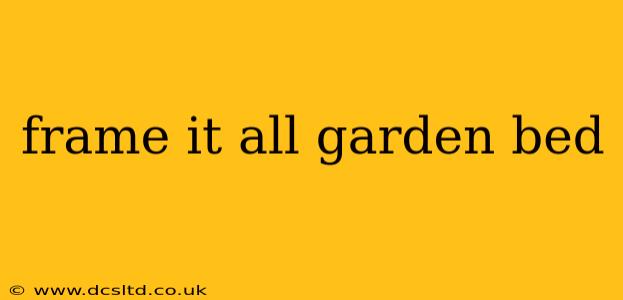Frame It All: Creating Stunning Garden Beds with Borders
Framing your garden beds isn't just about aesthetics; it's about creating functional and beautiful spaces that enhance your landscaping. A well-defined border elevates the overall look of your garden, making plants pop and adding a touch of sophistication. This guide explores various framing options, considerations for choosing the right material, and tips for creating a stunning framed garden bed.
What are the benefits of framing a garden bed?
Framing your garden bed offers a multitude of benefits beyond the purely aesthetic. A defined border helps contain soil, preventing it from spreading into surrounding areas and keeping your lawn neat. It also provides a visual separation between different garden areas and your lawn, creating a more organized and polished landscape. Furthermore, the frame itself can act as a physical barrier, deterring pests and preventing weeds from encroaching on your precious plants. Finally, a frame can add height and structure, giving your garden a more defined and intentional look.
What materials can I use to frame my garden bed?
The choice of framing material depends largely on your budget, the style of your garden, and the overall aesthetic you're aiming for. Here are some popular options:
- Bricks: Classic and durable, bricks offer a timeless look that complements many garden styles. They're readily available and relatively easy to install.
- Stone: Natural stone provides a rustic and elegant feel, adding a touch of sophistication to your garden. Various types of stone are available, allowing you to choose the perfect fit for your landscaping. Consider local stone for a more sustainable and cost-effective option.
- Timber: Wood offers a warm and natural look, blending seamlessly with many garden designs. However, it requires regular maintenance to prevent rot and decay. Choose treated timber for longevity.
- Metal: Metal edging, such as aluminum or steel, offers a modern and sleek look. It's durable and low-maintenance but can be more expensive than other options.
- Plastic: Plastic edging is a budget-friendly and readily available option. However, it can look less aesthetically pleasing than other materials and may not last as long.
How do I choose the right size and shape for my garden bed frame?
The size and shape of your garden bed frame should complement your existing landscaping and the overall design of your garden. Consider the following:
- Scale: The frame should be proportionate to the size of your garden bed. A large, imposing frame might overwhelm a small garden bed, while a tiny frame might get lost in a larger space.
- Shape: Straight lines create a formal and structured look, while curved lines offer a more natural and flowing aesthetic. Experiment with different shapes to find the perfect fit for your garden.
- Existing Structures: Consider the existing structures in your garden, such as pathways, patios, or buildings. The frame should complement these features, creating a cohesive and unified design.
How high should the frame be?
The height of your frame should depend on the type of plants you're growing. Taller plants require a taller frame to prevent soil erosion and provide support. However, a very tall frame might overshadow smaller plants, so it's important to find a balance. Generally, a height of 4-6 inches is suitable for most garden beds.
What are the best plants to use in a framed garden bed?
The best plants for a framed garden bed depend on your climate, soil conditions, and personal preferences. However, consider using a mix of textures, colors, and heights to create visual interest. Use taller plants towards the back and shorter plants towards the front to create depth and layering. Consider incorporating both flowering and foliage plants for a more dynamic display.
How do I install a garden bed frame?
Installing a garden bed frame involves several steps:
- Planning and Design: Determine the size, shape, and material of your frame.
- Preparation: Clear the area of weeds and debris. Mark out the boundaries of your garden bed.
- Installation: Follow the manufacturer's instructions for installing your chosen material. This may involve digging a trench, setting the frame in place, and backfilling with soil.
- Finishing Touches: Once the frame is installed, add topsoil and plant your chosen plants.
By following these steps and incorporating your own creative vision, you can create a stunning and functional framed garden bed that will enhance the beauty of your outdoor space for years to come. Remember to consider the overall style of your garden and choose materials that complement your existing landscape.
